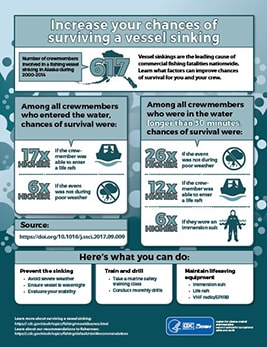Vessel Disasters

Aerial photo of a partially submerged commercial fishing vessel with oil containment booms surrounding the vessel. Photo by USCG
Vessel disasters, such as sinkings or capsizings, are the leading contributor to fatalities among commercial fishermen. Of fatal vessel disasters that occurred during 2000-2019:
- Vessel disasters resulted in 47% of all deaths in the U.S. fishing industry
- 414 fishermen died in 245 vessel disaster events
- Inclement weather was a contributing factor in 54% of cases
- Flooding and instability were the most common initiating events
(Source: NIOSH Commercial Fishing Incident Database)
NIOSH has researched the prevention and survival of vessel disasters through fisheries management policies, engineering interventions, preventive maintenance, and use of lifesaving equipment.
The Magnuson-Stevens Fishery Conservation and Management Act includes 10 standards to guide development of fishery management programs. Within the act, National Standard 10 relates to the safety of life at sea. Fishery management regimes can affect safety by influencing when and how operators fish. Factors such as choosing to fish in inclement weather, boat size, crew size and experience, and work/rest schedules can all be impacted by fishery management policies.
NIOSH has evaluated the impact of several fishery management programs, such as the Alaska halibut/sablefish individual fishing quota (IFQ) program and the rationalization of the Bering Sea/Aleutian Island crab fleet. NIOSH researchers also participate in fishery management council meetings and contribute to program reviews, oftentimes describing safety incidents in specific fisheries over time.

Flooding is the most common initiating event in vessel disasters. NIOSH has worked to prevent catastrophic flooding through the development of engineering controls.
Open doors and hatches can allow water ingress and reduce the watertight integrity of a vessel. NIOSH developed a <a href=”http://www.wapatoengineering.com/products/monitor/”>hatch and door monitoring system</a> for commercial fishing vessels, which is inexpensive, easy to install, robust, and able to be retrofitted on existing vessels.
Most flood alarms found on commercial fishing boats prompt pumps to operate, but do not indicate the status of the flooding or relative performance of the pumps. NIOSH engineers have developed a Flood-Rate Monitor that not only triggers the pumps but also shows whether the pumps are gaining, maintaining, or failing to keep up with the flooding. This information is sent to the wheelhouse for the captain and crew to respond to the risk.

A fish hold or tank that is not entirely full is referred to as a “slack tank” and dangerously reduces a ship’s stability due to the “free surface effect,” a condition where water can slosh back and forth in a confined space. Traditional float-style switches used to sense tank levels were unreliable due to their propensity to get clogged with debris. A Slack-Tank Monitor using pressure transducers to detect tank levels was designed to reduce the chances of mechanical failure due to fouling from machine oil, grease, fish slime, or debris.
The U.S. Coast Guard, in partnership with industry, developed the Alternative Compliance Safety Agreement (ACSA) to create risk-based safety guidelines to reduce vessel casualties. ACSA guidelines focused on watertight integrity, vessel stability, and material condition of the vessel’s systems, like the shaft, rudder, and machinery. NIOSH conducted a review of ACSA and found that compliance with the program led to a reduction in vessel disasters.
NIOSH research also found that less serious vessel casualties, such as minor flooding or loss of power/propulsion/steering, are risk factors for future vessel disasters. This highlights the importance of conducting preventive maintenance and enacting safety management systems to ensure good operating condition of vessels and their systems.
 [PDF - 436 KB]
[PDF - 436 KB]NIOSH Surviving a vessel sinking infographic.
Most of the current U.S. Coast Guard safety regulations in the commercial fishing industry are focused on surviving a vessel disaster. The Commercial Fishing Industry Vessel Safety Act (CFIVSA) of 1988 gave the Coast Guard authority to develop necessary lifesaving regulations for commercial fishing vessels, including requirements to carry emergency equipment such as life rafts and immersion suits.
NIOSH first evaluated the impact of CFIVSA on fatalities in Alaska in the 1990s. This evaluation found that the safety requirements contributed to 94% of the commercial fishermen surviving vessel disasters during 1997-1999, in comparison to a 77% survival rate in 1991-1993. For more details on these findings please refer to the published reports, “Preventing commercial fishing deaths in Alaska” and “Improving Safety in the Alaskan Commercial Fishing Industry.”
More recently, NIOSH studied the impact of emergency equipment on survival during a vessel disaster. The results show that crewmembers involved in fishing vessel sinkings in Alaska were 17 times more likely to survive if they used a life raft after entering the water. For crewmembers who were in the water for over 30 minutes, chances of survival were 12 times greater if they boarded a life raft and six times greater if they wore an immersion suit. This study supports life rafts and immersion suits in saving lives and the need for training and enforcement of the use of this type of equipment.
- Take a marine safety training class at least once every five years. Safety training for fishermen is available, affordable, and saves lives. All fishermen should learn and know how to use basic lifesaving equipment like immersion suits, life rafts, EPIRBs, and fire extinguishers to improve their chances of survival in an emergency.
- Participate in monthly drills on the vessel, including abandon ship, flooding, and fire. The practical knowledge learned in safety training should be applied each month during drills, allowing fishermen to reinforce the skills needed in an emergency.
- Ensure the watertight integrity of the vessel. The hull and through-hull penetrations should be regularly inspected and maintained. Doors and hatches should remain closed while underway, especially in rough seas. Maintain and test high water alarms before each trip.
- Maintain proper watch. Vessel owners and operators should create fatigue management policies and use watch alarms to prevent groundings and collisions.
- Adhere to federal commercial fishing vessel safety regulations. All owners and operators should ensure they are in compliance with appropriate safety regulations. While decked vessels and skiffs differ both physically and operationally, both are commercial fishing vessels. Those working in skiffs should be aware of regulations and exemptions surrounding survival equipment carried on board.
- Adhere to stability instructions (if applicable). A naval architect should be consulted periodically to review safe loading limits of the vessel. Vessels should always be loaded in compliance with their stability instructions.
United States Coast Guard
The US Coast Guard provides training, educational materials, and dockside exams for commercial fishermen.
Alaska Marine Safety Education Association (AMSEA)
AMSEA provides effective hands-on marine safety courses to the commercial fishing industry in Alaska and in other regions of the United States.
North Pacific Fishing Vessel owners Association (NPFVOA)
NPFVOA provides hands-on marine safety training to commercial fishermen in the Pacific Northwest.
